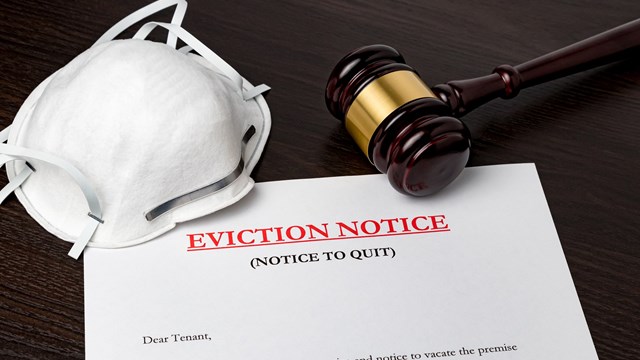Removing a disruptive, abusive, non-paying, or otherwise problematic tenant from a rental building is relatively easy. Doing the same thing in a co-op is also possible, though substantially harder. But removing a condo owner from the premises (and effectively wiping out his or her equity position as a member of the condominium association) is very difficult indeed, and subject to very narrow legal interpretation—yet is doable under certain circumstances.
While theoretically a co-op shareholder could be evicted for non-monetary issues (prolonged patterns of harassment; ceaseless petty litigation against neighbors or the cooperative corporation; and criminal activity are a few examples), the same is virtually impossible in a condominium setting. Condominiums are pure real estate, not shares in a corporate entity. As a matter of fact, from a legal standpoint, even the word ‘eviction’ cannot be used relative to removing a condo owner, though it can be applied to removing a rental tenant in a condominium unit—a point we will return to later. The closest we can come to a legally recognizable term for this type of action is a removal.
Generally speaking, points of law on this subject are consistent from state to state with only slight variations. The important distinctions relate to whether the person being removed is the owner of a unit, or that owner’s tenant. In both cases, laws are consistent on the most basic matters. Some states’ statutes have slightly differing approaches and nuances, a point we will return to later.
Removing a Condo Owner
Julie Schechter is a partner with Armstrong Teasdale, a law firm based in Manhattan. She explains that, unlike the cooperative corporation, a condominium association has recourse against a unit owner only for monetary defaults issues – almost exclusively nonpayment of common charges. Owners cannot be removed for bad behavior. She outlines the process as follows:
“When a condominium is owed common charges, the board can file a lien against the owner’s unit. Once the lien has been filed, the board has two options: it can bring an action to recover the money due, or it can foreclose on the lien. A lawsuit to recover the money due is less expensive and faster than a lawsuit to foreclose the lien, but neither is very fast. If the board is successful in a lawsuit to recover the money due, it will obtain a money judgment that can be enforced against bank accounts or other assets of the unit owner. The assistance of an enforcement official – specifically a city marshal or sheriff – is required to enforce the judgment.”
Alternatively, “an action can be brought to foreclose the lien that is similar to a mortgage foreclosure action,” Schechter continues. “If the action is successful, the result is a judgment to sell the unit and apply the proceeds to payment of the debt. It is important to note that in the event there is a first mortgage on the unit, the bank’s lien is superior to the condominium’s lien. There may be one other step that can be taken to encourage the unit owner to pay the money due. Depending on the particular community’s bylaws, rules and regulations, it may be possible to suspend certain non-essential services that the unit owner receives.”
Scott Piekarsky, Managing Member with the law firm of Piekarsky & Associates in Wyckoff, New Jersey, says: “In terms of getting a condo owner out of their unit, it’s not like a landlord/tenant situation. The only way to remove an owner is if he or she defaults and you can get a lien, foreclose the lien, get a sheriff’s sale, and dispose of the unit.” And it has to be for monetary default. “If it’s non-monetary, you can get sanctions and fees, and maybe some monetary relief, but it’s virtually impossible to remove someone if they own the unit.”
The statutes elsewhere are pretty much identical. Eric Thulin, an associate at the Needham, Massachusetts-based law firm Goldman & Pease, says: “First and foremost, the association would have to establish a lien against the unit.” However, he explains that “the board isn’t left without remedy.” In the event of non-monetary default, an association can seek an execution for possession, which gives the association the right to take back possession of the unit, though it does not wipe out the owner’s equity position. Though Thulin has seen such actions brought before the court, he hasn’t brought one himself.
Removing an Owner’s Tenant
While it’s certainly possible, removing a tenant from an investor unit is not particularly easy either. Schechter explains: “Condominium boards lack legal standing to remove unit owners’ tenants, regardless of how offensive their behavior may be. Even if the tenant were to be in constant violation of a provision of the condominium’s bylaws or rules and regulations, the condominium is still unable to remove the tenant because the condominium is not in privity with the tenant. (Privity is a relationship between two parties that is recognized by law – typically blood, lease, or service. -Ed) The condominium unit owner, however, is in privity with its tenant and can take action to evict the tenant.”
That said, Thulin points out that unit owners are “locked into the rules and regulations set forth in governing documents when they buy a unit, because presumably they’ve read and agreed to them; they can’t say they didn’t know. A reasonable expectation is that they and/or their tenants will comply with those rules and regulations.” Despite that, “there is very little that can be done by an association to remove a tenant from a unit leased out by its owner. If the tenant violates the rules and regulations, the unit owner has an obligation to begin proceedings” to remove the tenant.
In New Jersey, explains Piekarsky, “the best leverage under most governing documents is when an association stands in the shoes of the owner. The owner has a renter; the renter is a problem, but the owner doesn’t take action. Many times, an association’s governing documents say the association may step into the owner’s shoes and take the necessary action. That’s the best leverage over a renter.”
New Jersey law also adds another layer to the resolution process in condominium disputes through alternative dispute resolution (ADR) – usually in the form of professional mediation or arbitration. New Jersey state law requires that all owners in condominiums be offered ADR before going to court. “The association can seek injunctive relief,” Piekarsky says. “I’ve never seen anyone forced out through injunctive relief, though. If they are a danger to themselves, others or the property, you can get a civil commitment, which would get the resident out.”
A Real-Life Example
Thulin relates a case that went before Boston Municipal Court: An owner in a suburban Boston condo association became the neighbor from hell. She was prescribed medication for a psychological condition, but decided to stop taking it and underwent what neighbors described as a profound personality change. She harassed both the association staff and her neighbors to the point where other owners feared for their safety. She was also delinquent in her common area charges.The court was sympathetic, and in lieu of proceeding to a foreclosure, directed a settlement – specifically an agreement for judgment, which is sort of like a stay of the foreclosure action. The owner agreed not to engage in offensive behavior, and to comply with her health care providers’ instructions regarding medication. If the behavior renewed, the association could then proceed to foreclosure. To date, there have been no further issues.
Not all situations end so neatly. The rights of the owner are squarely in the path of an association trying to remove an offending resident, whether a unit is leased out or owner-occupied. Attorneys interviewed by The Cooperator are in general agreement that if there’s no monetary default, the path to removal of a problem owner is pretty much blocked. The optimal situation for an association is when the unit owner is in default on monthly common charges. The association then has the right to request a receiver to step in and collect rent from the tenant, which can then be turned directly over to the association for both current charges and to make up arrears.
A similar tactic for a non-paying owner is described by Schechter: “While a unit owner in a condominium cannot be removed for nonpayment of common charges, there are tactics that can be utilized by condo boards to accomplish the same result. For example, during a foreclosure action, a condominium can request the court appoint a receiver to collect rent from the unit. If the unit owner is still living in the unit and refuses to pay the rent ordered by the receiver, the condominium board can bring an action to remove the unit owner for failure to comply with the receiver’s order. If the action is successful, the unit owner can be removed.”
Overall, the power of a condominium association is limited when it comes to removing troublesome or non-paying owners and/or their tenants. Because of those limitations – and because the available legal remedies are so slow going – associations should act quickly, turning over potential problem situations to their attorney for resolution as soon as they’re aware there’s an issue. Dawdling will only cause unpaid charges or offensive incidents to pile up. Ownership comes with rights and responsibilities – as does the stewardship of board members. Both should be taken seriously and acted on with alacrity.
AJ Sidransky is a staff writer/reporter for The Cooperator, and a published novelist.







5 Comments
Leave a Comment